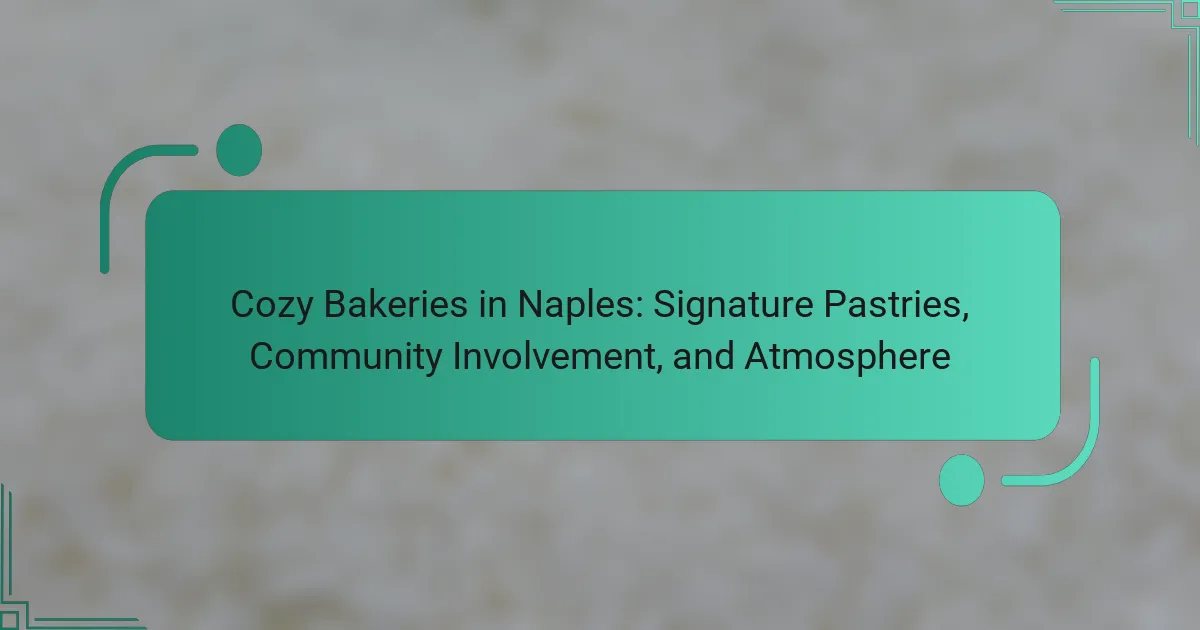Cozy bakeries in Naples are distinguished by their traditional recipes and use of local ingredients, offering signature pastries such as sfogliatella and babà that reflect the region’s culinary heritage. These bakeries play a vital role in the community by hosting events, supporting local artisans, and collaborating with farmers to ensure fresh products. The inviting atmosphere, characterized by rustic decor and the aroma of baked goods, fosters social interaction among patrons. Additionally, many bakeries engage in charitable initiatives, addressing food insecurity and enhancing community ties. Overall, Naples’ bakeries exemplify a blend of quality, tradition, and community involvement.

What Makes Bakeries in Naples Unique?
Bakeries in Naples are unique due to their traditional recipes and local ingredients. Many bakeries feature pastries that reflect the region’s culinary heritage. Signature items include sfogliatella and babà, both of which have historical significance. The use of fresh, locally sourced ingredients enhances flavor and quality. Community involvement is also prominent; bakeries often host events and support local artisans. The atmosphere in these bakeries is warm and inviting, fostering a sense of connection among patrons. This combination of tradition, quality, and community makes Naples bakeries stand out.
How do Naples bakeries reflect local culture?
Naples bakeries reflect local culture through their traditional recipes and communal atmosphere. They often serve iconic pastries like sfogliatella and babà, which are deeply rooted in Neapolitan history. These baked goods celebrate local ingredients, such as citrus fruits and ricotta, showcasing the region’s agricultural heritage. Bakeries also function as social hubs, where locals gather to share stories and enjoy coffee alongside pastries. This fosters a sense of community and belonging. Furthermore, many bakeries participate in local festivals, reinforcing cultural traditions and pride. Their architecture often features historical elements, connecting the present with Naples’ rich past.
What traditional baking methods are used in Naples?
Traditional baking methods used in Naples include wood-fired ovens and slow fermentation. Wood-fired ovens create high temperatures, essential for authentic Neapolitan pizza. This method ensures a crispy crust and properly cooked toppings. Slow fermentation enhances the dough’s flavor and texture. It typically involves using natural yeast and allowing the dough to rise over an extended period. These techniques are rooted in Naples’ culinary history, emphasizing quality ingredients and artisanal craftsmanship. The combination of these methods results in signature pastries and breads unique to the region.
How do local ingredients influence bakery offerings?
Local ingredients significantly influence bakery offerings by enhancing flavor and freshness. Bakeries that source ingredients locally often create products that reflect regional tastes. This practice fosters a connection between the bakery and the community. For instance, using local grains can lead to unique bread textures and flavors. Seasonal fruits from nearby farms can inspire limited-time pastries. Additionally, local ingredients promote sustainability and support local economies. Research indicates that consumers prefer products made with regional ingredients, as they perceive them as higher quality. This trend encourages bakeries to innovate and diversify their menus based on available local produce.
What are the main characteristics of cozy bakeries?
Cozy bakeries are characterized by a warm, inviting atmosphere. They typically feature comfortable seating arrangements that encourage patrons to linger. The decor often includes rustic elements like wooden furniture and soft lighting. A selection of freshly baked goods is usually displayed prominently. The aroma of baked goods enhances the overall experience. Many cozy bakeries prioritize local ingredients, supporting community farmers. They often host events or workshops to engage with the community. Personalized customer service is a hallmark trait, making patrons feel valued and welcomed.
What elements contribute to a cozy atmosphere in bakeries?
Warm lighting creates an inviting ambiance in bakeries. Soft, warm hues reduce harsh shadows and enhance comfort. Comfortable seating encourages patrons to linger. Plush chairs and intimate tables foster relaxation and conversation. The aroma of freshly baked goods adds to the cozy experience. Scents like bread and pastries evoke warmth and nostalgia. Decor featuring rustic elements enhances the homey feel. Wooden accents and vintage decor create a welcoming environment. Background music plays softly to complement the atmosphere. Gentle melodies promote a serene and enjoyable space. Together, these elements create a cozy atmosphere that invites customers to enjoy their time.
How does interior design affect customer experience?
Interior design significantly affects customer experience by influencing emotions and behaviors. A well-designed space can create a welcoming atmosphere. This encourages customers to stay longer and engage more with the offerings. For example, research shows that warm colors and comfortable seating enhance feelings of relaxation. In contrast, cluttered or poorly lit environments can lead to discomfort and quick exits. Additionally, the layout of a bakery can guide customer flow, making it easier to navigate. Effective design also reflects the brand’s identity, creating a memorable experience. Studies indicate that customers are more likely to return to places where they felt a positive ambiance.
What signature pastries are offered in Naples bakeries?
Naples bakeries offer a variety of signature pastries. Notable examples include sfogliatella, a shell-shaped pastry filled with ricotta cheese and semolina. Babà is another popular treat, known for its rum-soaked sponge cake. Pastiera is a traditional Easter pastry made with ricotta, wheat, and orange flower water. Zeppole are cream-filled pastries often enjoyed during Saint Joseph’s Day. These pastries reflect Naples’ rich culinary heritage and are beloved by both locals and visitors.
What are the most popular pastries in Naples?
The most popular pastries in Naples include sfogliatella, babà, and pastiera. Sfogliatella is a shell-shaped pastry filled with ricotta and candied fruit. Babà is a rum-soaked sponge cake, often served with whipped cream. Pastiera is a traditional Easter cake made with ricotta, wheat, and orange blossom. These pastries are iconic in Neapolitan cuisine and are celebrated for their unique flavors and textures. They reflect the rich culinary heritage of Naples.
How are these pastries prepared and presented?
Pastries in cozy bakeries in Naples are typically prepared using traditional recipes and high-quality ingredients. The preparation process often involves mixing flour, sugar, butter, and eggs to create the dough. Bakers may use specific techniques such as folding, rolling, and proofing to achieve desired textures.
Once the pastries are shaped, they are baked until golden brown. Presentation is equally important; pastries are often dusted with powdered sugar or glazed for shine. They may be arranged on decorative plates or in display cases to enhance visual appeal.
Many bakeries incorporate local flavors or seasonal ingredients, reflecting the community’s culinary heritage. This attention to detail in preparation and presentation ensures that each pastry is not only delicious but also visually enticing.

How Do Bakeries Engage with the Community?
Bakeries engage with the community through various initiatives. They often host local events such as baking classes and seasonal festivals. These activities promote interaction between bakers and community members. Bakeries may also collaborate with local farmers for fresh ingredients. This supports local agriculture and enhances product quality. Many bakeries donate goods to local charities and shelters. This helps address food insecurity in the community. Additionally, they may participate in community markets and fairs. This allows them to showcase their products and connect with potential customers.
What role do bakeries play in local events?
Bakeries play a crucial role in local events by providing food and fostering community engagement. They offer a variety of baked goods that enhance the atmosphere of celebrations. Bakeries often supply cakes, pastries, and bread for parties, weddings, and festivals. Their products contribute to the culinary experience of these gatherings. Additionally, bakeries frequently participate in local events, showcasing their offerings to the community. This participation helps strengthen local ties and supports small businesses. For instance, events like farmers’ markets often feature local bakeries, promoting their goods and connecting them with customers.
How do bakeries contribute to community celebrations?
Bakeries contribute to community celebrations by providing essential baked goods for events. They create specialty items like cakes, pastries, and bread tailored for holidays and local festivities. These baked goods often symbolize cultural traditions and enhance the celebratory atmosphere. For instance, bakeries may offer seasonal treats during Christmas or unique pastries for local festivals. Additionally, bakeries often collaborate with community organizations to sponsor events or donate products. This involvement fosters a sense of unity and local pride among residents. Their presence in celebrations strengthens community bonds and supports local economies.
What partnerships do bakeries form with local organizations?
Bakeries often form partnerships with local organizations such as schools, charities, and farmers’ markets. These collaborations can involve providing baked goods for events or fundraisers. For example, a bakery might donate pastries to a local school for a bake sale. Additionally, bakeries may partner with farmers’ markets to source fresh, local ingredients. This not only supports local agriculture but also enhances the bakery’s offerings. Such partnerships can strengthen community ties and promote mutual benefits. Studies show that local businesses engaging with community organizations often see increased customer loyalty.
How do bakeries support local farmers and producers?
Bakeries support local farmers and producers by sourcing ingredients directly from them. This practice fosters local economies and reduces transportation costs. Many bakeries prioritize using seasonal and organic produce. This ensures freshness and quality in their baked goods. By purchasing grains, fruits, and dairy locally, bakeries create partnerships with farmers. These collaborations often lead to unique, region-specific products. Additionally, bakeries may feature local ingredients prominently in their marketing. This highlights their commitment to community and sustainability. Such practices help strengthen the local food system and promote agricultural diversity.
What types of local ingredients are commonly sourced?
Local ingredients commonly sourced by bakeries in Naples include flour, dairy, fruits, and nuts. Flour is often obtained from regional mills, ensuring freshness and quality. Dairy products, such as milk and cheese, are sourced from local farms, enhancing flavor. Seasonal fruits, including citrus and berries, are harvested from nearby orchards. Nuts, like almonds and hazelnuts, are often locally grown, adding texture and taste to pastries. These ingredients contribute to the authentic flavors of Neapolitan pastries. Sourcing locally supports community agriculture and promotes sustainability.
How does supporting local producers benefit bakeries?
Supporting local producers benefits bakeries by enhancing product quality and fostering community relationships. Local ingredients often have superior freshness and flavor. This quality can elevate the taste of baked goods. Bakeries that source locally can also differentiate themselves in a competitive market. This unique selling point attracts customers who value local goods. Additionally, supporting local producers strengthens the local economy. It creates a network of support among businesses. This interconnectedness can lead to collaborative marketing efforts and events. Ultimately, these factors contribute to the bakery’s reputation and customer loyalty.

What Atmosphere Can Be Expected in Cozy Bakeries?
Cozy bakeries typically offer a warm and inviting atmosphere. The ambiance is often characterized by soft lighting and comfortable seating. Many have the aroma of freshly baked goods filling the air. Decor often includes rustic elements like wooden furniture and charming decorations. This creates a sense of homeliness and comfort for patrons. Community interaction is encouraged, with spaces designed for socializing. Customers often find a mix of locals and visitors enjoying the space together. Overall, cozy bakeries foster a relaxed and friendly environment.
How does ambiance affect customer satisfaction in bakeries?
Ambiance significantly affects customer satisfaction in bakeries. A welcoming atmosphere enhances the overall experience for customers. Elements such as lighting, decor, and music contribute to this ambiance. Research shows that pleasant environments increase customers’ willingness to return. A study published in the Journal of Retailing found that 62% of customers felt more satisfied in aesthetically pleasing settings. Additionally, comfortable seating and cleanliness promote longer visits and higher spending. Overall, a positive ambiance creates a connection between customers and the bakery, fostering loyalty and satisfaction.
What sensory elements enhance the bakery experience?
The sensory elements that enhance the bakery experience include aroma, taste, texture, and visual appeal. The aroma of freshly baked goods creates an inviting atmosphere. Studies show that pleasant smells can trigger positive emotions and memories. Taste is crucial as it determines the enjoyment of pastries and breads. Texture contributes to the overall satisfaction, with contrasts like crispy crusts and soft interiors. Visual appeal, including presentation and colors, attracts customers and enhances their anticipation. Together, these elements create a memorable bakery experience that engages multiple senses.
How do bakeries create a welcoming environment for customers?
Bakeries create a welcoming environment for customers through inviting decor and friendly staff. Comfortable seating areas encourage customers to relax and enjoy their purchases. The aroma of freshly baked goods enhances the sensory experience. Bright lighting and warm colors contribute to a cozy atmosphere. Engaging displays of pastries attract attention and stimulate appetite. Community involvement through events fosters a sense of belonging. Personalized service makes customers feel valued and appreciated. These elements combined create a positive and inviting space for patrons.
What are the best practices for enjoying the bakery experience?
To enjoy the bakery experience, engage your senses fully. Start by observing the bakery’s ambiance. Look for comfortable seating and inviting decor. Smell the fresh baked goods; aromas enhance the experience. Taste a variety of pastries to appreciate different flavors and textures. Consider pairing pastries with coffee or tea for a complementary experience. Interact with staff to learn about signature items and baking techniques. Share your experience with friends to enhance enjoyment through social interaction. These practices create a memorable and satisfying bakery visit.
How can customers choose the best pastries to try?
Customers can choose the best pastries to try by considering freshness, ingredients, and recommendations. Fresh pastries typically have a superior taste and texture. Customers should ask about the baking schedule to ensure they are sampling items made that day. High-quality ingredients, such as organic flour and real butter, contribute significantly to flavor. Reading reviews or asking staff for popular selections can guide choices. Additionally, customers can observe the variety available, as a diverse selection often indicates a bakery’s expertise. Seasonal specialties may also provide unique flavors worth trying.
What tips can enhance the overall experience in a cozy bakery?
To enhance the overall experience in a cozy bakery, focus on ambiance, quality products, and customer service. A warm, inviting atmosphere encourages customers to linger. Soft lighting and comfortable seating can make the space feel more welcoming. Offering freshly baked goods made from quality ingredients attracts repeat customers. Seasonal items can create excitement and variety. Engaging staff who provide friendly service can enhance customer satisfaction. Additionally, hosting community events fosters a sense of belonging. These elements collectively contribute to a memorable bakery experience.
Cozy bakeries in Naples are characterized by their traditional recipes, signature pastries, and strong community involvement. The article explores unique offerings such as sfogliatella and babà, highlighting the use of locally sourced ingredients and traditional baking methods that enhance flavor and quality. It also discusses the inviting atmosphere of these bakeries, emphasizing their role as social hubs where locals gather. Additionally, the article examines how bakeries engage with the community through events, support local farmers, and create a warm ambiance that fosters customer satisfaction.



